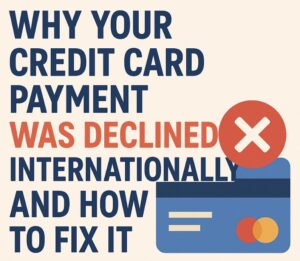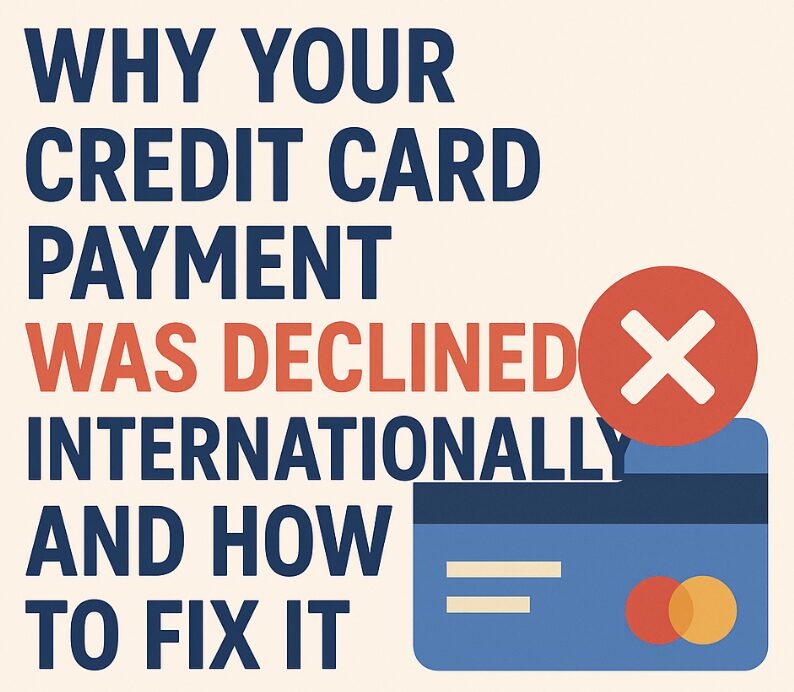Imagine this: you’re on vacation abroad, standing in line at a café, and when it’s your turn to pay, your credit card is suddenly declined. Embarrassing? Sure. Frustrating? Absolutely. But you’re not alone—this is a common issue that many travelers face.
Understanding why your card was declined when traveling internationally can help you fix the problem quickly and avoid it in the future. Let’s dive into the most common reasons and what you can do to resolve the issue.

Common Reasons Why Your Credit Card Was Declined Abroad
There are a variety of reasons why your card might not go through when you’re overseas. Some are simple, and some require a bit more troubleshooting.
1. Your Card Was Flagged for Fraud Detection
Banks and credit card companies use automated systems to detect unusual activity. If you’re suddenly using your card in Spain when you’ve never been there before, your bank might assume it was stolen and block the transaction.
How to fix it: Call the number on the back of your card and confirm the transaction was made by you. It’s helpful to notify your bank of travel plans before leaving the country using their app or website.
2. Your Card Isn’t Enabled for International Transactions
Some cards are not set to work overseas by default, especially debit or prepaid cards. Even if you’ve used your card internationally before, recent changes in bank policy might require reactivation.
How to fix it: Log into your online banking or call your issuer and ensure that international usage is enabled.
3. Insufficient Funds or Credit Limit Reached
You might have unknowingly hit your card’s limit, especially if foreign transactions are higher due to exchange rates or additional fees.
How to fix it: Check your available balance and recent charges. Keep track of your spending and consider raising your credit limit if you often travel.
4. Your Bank Doesn’t Allow Foreign Currency Transactions
Some smaller banks or specific credit card programs might block transactions that aren’t made in your home currency.
How to fix it: Use a travel-friendly credit card that supports multiple currencies and doesn’t charge foreign transaction fees.
5. The Merchant’s Payment Terminal Has Issues
Sometimes the issue isn’t with your card but with the merchant. Their terminal might not accept your type of card (e.g., AMEX), or it might have a technical glitch.
How to fix it: Try a different card or ask if they accept other forms of payment like mobile wallets. You can also try again at another nearby location.
6. Country-Specific Sanctions or Restrictions
Some countries are flagged for high risk or are under financial sanctions. If you’re in a restricted country, your bank may block any attempts to use your card.
How to fix it: Unfortunately, there’s often not much you can do in this situation. Using cash or alternative payment methods like Wise or Revolut might be your best option.
Tips to Prevent International Card Declines
Avoid future issues with a few proactive steps:
Inform your bank of travel plans ahead of time.
Carry multiple cards from different issuers (Visa, MasterCard, AMEX).
Use a card with no foreign transaction fees.
Enable travel notifications in your banking app.
Have a backup payment method like a prepaid travel card or digital wallet.
Best Travel-Friendly Credit Cards
Consider applying for cards known to perform well internationally:
Chase Sapphire Preferred: No foreign transaction fees, travel rewards.
Capital One Venture Rewards: Simple earning system and widely accepted.
American Express Platinum: Premium perks and concierge service, but check AMEX acceptance in some countries.
These cards often offer fraud protection, emergency services, and even lounge access—all useful when traveling.
Know Your Options When You’re Stuck
If your card is declined and you don’t have an alternative, here’s what to do:
Call your bank’s international support line
Use a money transfer app like Wise to send yourself funds
Ask your hotel or restaurant to hold your bill while you sort it out
Use mobile payment apps if accepted (e.g., Apple Pay, Google Pay)
Empower Your Travels with the Right Payment Tools
Travel should be about experiences—not payment headaches. Equip yourself with credit cards designed for travel, notify your bank before a trip, and always carry a backup. If you do get declined, stay calm—it’s usually an easy fix with a quick phone call or card switch.
Avoiding these common pitfalls can save you time, embarrassment, and even money. Travel smart, and make sure your wallet is just as ready for adventure as you are.
